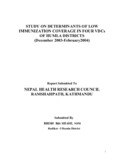Please use this identifier to cite or link to this item:
https://hdl.handle.net/20.500.14356/513Full metadata record
| DC Field | Value | Language |
|---|---|---|
| dc.contributor.author | Shahi, Brish Bdr | |
| dc.date.accessioned | 2013-01-10T06:20:27Z | |
| dc.date.accessioned | 2022-11-08T10:15:46Z | - |
| dc.date.available | 2013-01-10T06:20:27Z | |
| dc.date.available | 2022-11-08T10:15:46Z | - |
| dc.date.issued | 2004-02 | |
| dc.identifier.uri | http://103.69.126.140:8080/handle/20.500.14356/513 | - |
| dc.description | Humla is a most far district from capital of Nepal with the difficult access. Airline service from Nepalgunj is the only way to the access. Next gate is 7 days walk from Surkhet or Achham district. It is the District with lowest immunization coverage in the country. Uncertainty started with the approval of research proposal. Fund release was in first December, with the start of winter season and condition of short time period. For me both of these factors are obstacles. But I was trying to my best to meet the condition. Anyway I managed to fly Simikot on the 6th December. Launthi with lowest EPI coverage but unfeasible was excluded from the study. Being feasible (within two days distance) and relatively less conflict affected area, I selected 4 VDCs of North and west from Simikot -Hepka, Khagalgaun, Muchu, Dandafaya as study area purposively. I divided this into 18 clusters according to village and selected 8 clusters randomly. This were Dhinga, Hepka, Chaunganfaya, Dharapori, Kermi, Chyaduk, Yalbang, Yangar villages. Objectives of my study are to find relation of various factors with immunization status, estimate vaccine coverage in the area and find determinants of low immunization. Only 81 children were studied though nearly 91 children of target group (13-24 month) were estimated in sample clusters. The number was small due to lack of small population in the study VDCs (Minimum 834 Khangalgaun to Maximum1626 Muchu) It was found that the immunization coverage of the community was BCG-83%, DPT1-74%, DPT2-62%, DPT3-48%, and Measles-59%. NID coverage -102%. In the same way completely immunized children were 43%, partially immunized children were 40% and not immunized children were 16%. Dropout is higher- 28% for BCG vs Measles and 35% for DPT1 vs DPT3. However no one in the community was able to show immunization card of their children, as it was not provided to them. No any socio-demogrphic variable is associated with immunization though coverage is higher for female than male and more farmers have immunized their children than that of other occupation. Nearly all have listened about immunization in general. But more than 90% don’t know about specific immunization BCG, DPT, Measles, Polio and proper age for immunization. More than 95% belief that immunization protects from all diseases. There is no fixed date and time for clinic. Only 35 % people get information on time however time of clinic is perceived convenient for majority of respondent. Clinic run irregularly for 53% of respondent and even very irregularly (Kahile Kanhi matra) in 30% clusters. Entire people perceived behavior of health worker and counseling after immunizationis either good or medium but not poor. More than 95% respondents had access to EPI clinic in their own residential village or within the walking distance of 1 hour (one way). In these aspect clinics are accessible but during rainy season (Jestha to Asoj) people especially mother of infant migrate to high altitude “Lekha” and clinics become inaccessible. Nearly 47% children suffered from high fever or severe pain or abscess for prolonged period (more than one week) after immunization. Odd Ratio is high for timely information not provided(6.91), clinic irregularity (6.57), distance of health institution more than one hour(4.69) and perceived side effect present (3.82). Main reason for non-immunization is given seasonal migration in the same VDCs in warm season, date not known and fear of pain/adverse effect. This study was done in only four VDCs and methodologically can’t be generalized for the whole district. However clinic regularity, health worker punctuality, management pattern, seasonal migration, are similar in the entire district. From this perspective this result may reflect whole district problem. | en_US |
| dc.language.iso | en_US | en_US |
| dc.subject | Low immunization on Humla | en_US |
| dc.title | Study on determinants of low immunization coverage in four VDCs of Humla districts(December 2003- February 2004) | en_US |
| dc.type | Technical Report | en_US |
| Appears in Collections: | Post Graduate Grant (PG) Reports | |
Items in DSpace are protected by copyright, with all rights reserved, unless otherwise indicated.

